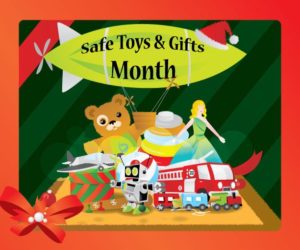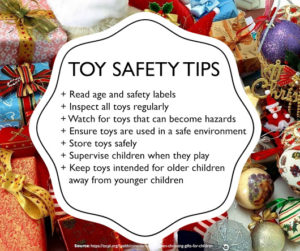In recent years, the U.S. Consumer Product Safety Commission (CPSC) has created a robust toy safety system, by requiring testing by independent, third party testing laboratories around the world; enforcing stringent lead and phthalatesPhthalates, or phthalate esters, are esters of phthalic anhydride. They are mainly used as plasticizers, i.e., substances added to plastics to increase their flexibility, transparency, durability, and longevity. They are used primarily to soften polyvinyl chloride. ( limits for toys; imposing some of the most stringent toy standards in the world; and stopping violative and dangerous toys at the ports and in the marketplace before they reach children’s hands). These combined efforts continue to foster the confidence of American families as they prepare to shop for toys this holiday season.
Safety tips to keep in mind this holiday season:
Balloons
Children can choke or suffocate on deflated or broken balloons. Keep deflated balloons away from children younger than eight years old. Discard broken balloons immediately.
Small balls and other toys with small parts
For children younger than age three, avoid toys with small parts, which can cause choking.
Scooters and other riding toys
Riding toys, skateboards and in-line skates go fast, and falls could be deadly. Helmets and safety gear should be worn properly at all times and they should be sized to fit.
Magnets
High-powered magnet sets are dangerous and should be kept away from children. Whether marketed for children or adults, building and play sets with small magnets should also be kept away from small children.
Button Batteries
Button batteries are typically about 20 millimeters in diameter, or between the size of a penny and a nickel, according to the National Capital Poison Center. They’re used in a wide variety of household items and products, including hearing aids, key fobs and children’s toys.
“The majority of the injuries from button batteries are going to be from swallowing them,” Martin explained, adding that the screws typically used to secure the batteries inside products can easily loosen.
“A lot of times, it doesn’t go all the way to the stomach [after swallowing],” Martin said of button batteries. “It gets stuck in the esophagus or occasionally the airway, and then in that position, it starts to create burns in those tissues and a lot of tissue damage in that area.”
That tissue damage in the esophagus and chest, Martin said, puts children particularly at risk of developing “blood vessel injuries [and] airway issues.”
“These can be very dangerous and this can absolutely be fatal,” Martin added.
“You can administer small sips of honey every couple of minutes on the way to the emergency department,” Martin explained. “It can decrease the risk of burns and tissue damage, and it can actually be lifesaving.” Martin stated.
Once gifts are open:
- Immediately discard plastic wrapping or other toy packaging before the wrapping and packaging become dangerous play things.
- Keep toys appropriate for older children away from younger siblings.
- Battery charging should be supervised by adults. Chargers and adapters can pose thermal burn hazards to young children. Pay attention to instructions and warnings on battery chargers. Some chargers lack any mechanism to prevent overcharging.
Toy Safety Guides
The CPSC provides free safety alerts, guides, posters, brochures, handbooks and other materials which you can use to help spread consumer product safety information in your community.
During December, participate in Safe Toys and Gifts Month. Since December is the biggest gift-giving month in the world, it’s important to keep safety in mind as you’re shopping for the little ones in your life.
According to the U.S. Consumer Product Safety Commission, 251,700 toy-related injuries were treated by hospital emergency rooms around the U.S. in 2010. Of those, 72% of them were people younger than 15 years old. A few years earlier, toy makers recalled over 19 million toys across the globe due to safety concerns like lead paint and small magnets. Since then, toy safety has improved, but shoppers can take precautions to keep children in their lives safe.
Buying toys and other gifts are one of the most exciting parts about the holiday season. Who doesn’t love watching a friend or family member open a gift and seeing their eyes light up with excitement?! In all the eagerness, it’s easy to forget about simple safety. So before making any purchases this year, keep safety in mind, so the holidays don’t turn from the happiest time of the year to the scariest!
When it comes to toys and gifts, it is critical to remember to consider the safety and age range of the toys.

